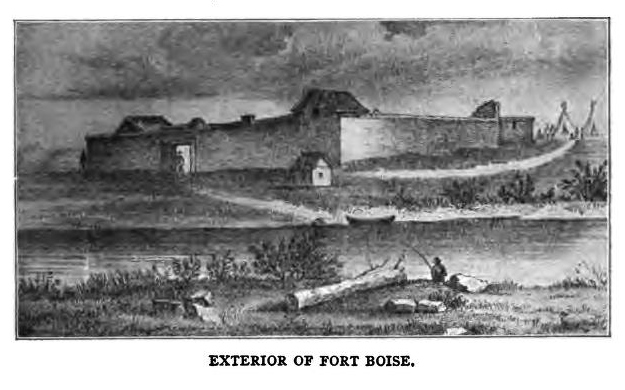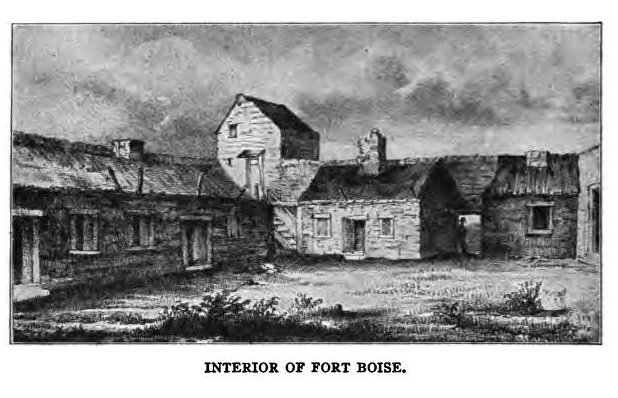Old Fort Boise
Abstracted from "History of the State of Idaho," by Cornelis J. Brosnan, published by Charles Scribner's Sons, 1918; p. 45-47.
57. The First or Temporary Fort Boise. – In 1834 the Hudson's Bay Company erected Fort Boise, its first Idaho trading-post. It was built by chief trader Thomas McKay on the Reed or Boise River about ten miles from its mouth. It was a simple log structure. In 1838 the site was changed to the east bank of the Snake River and a short distance north of the mouth of the Boise River In the summer of 1836 the Whitman party were guests at this little Boise River post. Mrs. Whitman, in her diary, tells us that at eleven o'clock on Sunday morning, August 21, 1836, in response to an invitation from his Hudson's Bay hosts Reverend H. H. Spalding preached a sermon at the fort. This was the second sermon preached within the boundaries of the present Idaho.
58. The Second or Permanent Fort Boise. - The second or permanent Fort Boise had a romantic and interesting history. The amount of the fur business transacted at this post was never large. Built for the purpose of drawing away business from Fort Hall, which had been erected earlier in 1834, Fort Boise had been a success, for in 1836 the Hudson's Bay Company acquired Fort Hall by purchase and that became their chief Idaho trading-post. The later Fort Boise became one of the celebrated stopping-points on the old Oregon Trail during the third and fourth decades of the last century. Here, after the long dusty journey over the Snake River plains, the tired and hungry emigrants were welcomed and often their scanty stores replenished. The outside walls were thick and durable and made of adobe or clay. Blockhouses were placed at the corners so as to protect the sides in case of attack. The main entrance opened on Snake River. Within the walls were several small buildings one story high and arranged around the four sides. They were used as storehouses for the peltry and for living quarters.

59. Francis Payette. – The most interesting character associated with old Fort Boise during the fascinating fur-trading and emigration period was Francis Payette. It was he who gave his name to Payette River and the city of Payette. The numerous emigrants who were the beneficiaries of his generous and polite hospitality have expressed their gratitude in many a touching tribute. Thomas J. Farnham, who visited Fort Boise in 1839, has left us this brilliant pen-picture of the courtly Payette:
6o. Farnham's Description of Francis Payette. -"Mr. Payette .. . received us with every mark of kindness; gave our horses to the care of his servants, and introduced us immediately to the chairs, table, and edibles of his apartments. He . . . is a merry, fat old gentleman of fifty, who, although in the wilderness all the best years of his life, has retained that manner of benevolence in trifles, of seating and serving you at table, of directing your attention continually to some little matter of interest, so strikingly agreeable in that mercurial [French-Canadian] people.
"The 14th and 15th [of September, 1839] were spent very pleasantly with this gentleman. During that time he feasted us with excellent bread, and butter made from an American cow, obtained from some of the missionaries; with baked, boiled, fried, and broiled salmon – and, at my request, with some of his adventures in the wilderness. On the i6th . . . a 'bon jour' having been returned by Mons. Payette, with the additional kind wish of a 'bon. voyage' to us over the mountains, we left the old gentleman to his solitary domain."

61. The Last Years of the Hudson's Bay Company in Idaho. - Although the Treaty of 1846 transferred to the United States title to that portion of the Oregon country lying south of the 49th parallel, yet the British flag with the letters H. B. C. (Hudson's Bay Company) woven in its folds continued to float over Fort Hall and Fort Boise for several years. Upon the breaking out of the Indian wars of 1855, these historic Idaho posts were abandoned. It was not until 1869 that the United States agreed to reimburse the Hudson's Bay Company for her possessory rights in Idaho, Oregon, and Washington. In its later years the company engaged in merchandising with the emigrants, retired trappers, and the Indians, and in cattle-raising more than in gathering fur.

Webspace for this site is generously provided by Genealogy Village and Access Genealogy
Copyright © 2013 - Sharon McConnel. All Rights Reserved.
